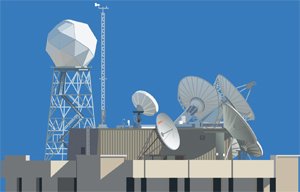 |
Director's NoteHank Revercomb |
October promises to be an exciting month, punctuated on the 25th by the launch of the NPP platform that will introduce the first truly new NOAA operational satellite series since the 3-axis stabilized GOES series began in 1994. NPP will be the first US element of the Joint Polar Satellite System (JPSS), consisting of the European MetOp series covering the AM orbit (930 local time) and this NOAA/NASA series covering the PM orbit (1330 local time). JPSS continues the civilian part of the long awaited and ill-fated NPOESS program that we had worked on under the Integrated Project Office for well over a decade.
JPSS will offer many advances compared to the current NOAA series. The current series had its debut way back in 1978 on TIROS-N, and has flown evolutionary versions of the TIROS-N instruments ever since (including the HIRS IR sounder, versions 1-4; MSU and SSU microwave sounders, replaced by AMSU in 1998, and AMSU-A and MHS in 2005; and the AVHRR imager, versions 1-3).
Because we have had the NASA EOS Terra and Aqua research platforms for the last decade, we know much of what to expect as new capabilities from JPSS, but the success of the new systems will assure that these advances are part of our operational capability for many years to come. We also know that in some regards there will be challenges and opportunities to make the new operational weather and climate products come up to the standards of our current MODIS-based imager research products.
One of those challenges will be making compatible products for the AM and PM orbits. As the initial offering of the first European polar orbiting operational system, the METOP-A launched in 2006 is a very sensible blend of the old and the new. Its payload includes all of the elements of the recent NOAA series (HIRS/4, AMSU-A, MHS and AVHRR/3), plus a huge step forward for IR sounding from IASI, the Infrared Atmospheric Sounding Interferometer with continuous high spectral resolution coverage from 3.7 to 15 microns. The capabilities of IASI have now been proven to match, and in some respects to significantly exceed, those offered by the AIRS on Aqua. Regarding imager products, however, the AM instrument complement does pose a major challenge to the creation of high spatial resolution products given the limitations inherent to its 6-channel AVHRR/3 imager.
For the PM platform, the 22 channel NPP imager, VIIRS (Visible Infrared Imager Radiometer Suite), will offer significant advances over AVHRR, with a spatial resolution that even exceeds that of the Terra and Aqua MODIS. It also includes a new night-time imaging capability that I’m sure will be exciting to explore. The major deficiency of VIIRS for atmospheric work is its lack of carbon dioxide and water vapor channels in infrared, a deficiency that many of you tried hard to get corrected. Now we are going to have to find ways to effectively meld the high spatial resolution information from the imaging channels of VIIRS with the vertical information from the lower spatial resolution advanced sounders, another significant challenge.
Regarding atmospheric temperature and water vapor sounding, we expect NPP with its CrIS (Cross-track Infrared Sounder) and new ATMS microwave temperature and moisture sounder to provide comparable advanced capabilities to the AM MetOp platform, and even to add some key new features. Both the CrIS and the ATMS are expected to offer advances in radiometric calibration and the ATMS has sampling characteristics that will allow it to better match the IR spatial sampling. But these observing capabilities are just a start. Optimizing our ability to make full use of AM and PM advanced sounder capability is going to present an important challenge and opportunity for many years to come.
Before closing, I should also remind you of the new opportunities that have been offered by the MetOp-A morning platform since 2006. Its extended payload also includes an Advanced Scatterometer (ASCAT) to provide all-weather ocean surface wind vector measurements over the ice-free global oceans, solar spectra for estimating the atmospheric content and profile of ozone, nitrogen dioxide, water vapor, oxygen/oxygen dimmer, bromine oxide, and other various gases from GOME-2, and a GPS-based radio occultation system for atmospheric temperature and moisture sounding (GRAS).
NPP and the follow-on JPSS/MetOp platforms present opportunities that are going to be an exciting part of our future. To those of you who have devoted many years to making this new observing system succeed, congratulations on your persistence and careful work. It has taken longer and been more difficult than expected, but I’m sure it is about to pay off. And we are ready for the launch: our new antenna stands ready on the Engineering Research Building, the Atmosphere PEATE (Product Evaluation and Algorithm Test Element) is ready to serve the NPP Science Team, and our own science groups are ready and eager to engage in early calibration and validation activities.
